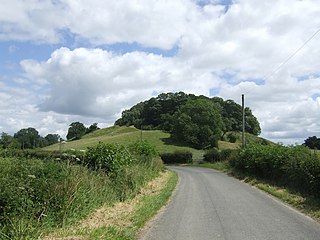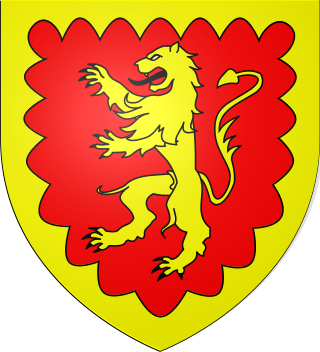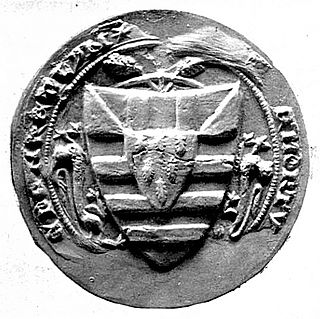See also
Surname list
This page lists people with the surname Pole. If an internal link intending to refer to a specific person led you to this page, you may wish to change that link by adding the person's given name(s) to the link.
The surname Pole usually derives from "Pool", a person associated with a body of water.
The Welsh de la Poles descended from Gruffydd ap Gwenwynwyn take their name from the previous association with the place Welshpool. The link between the knightly de la Poles of Wales (pre-1300), and William de la Pole (Chief Baron of the Exchequer), of Hull and his descendants, is uncertain and unproven. It is presented as fact in some genealogies (See Parentage of William de la Pole (d.1366)). Additionally some medieval contemporaries may have been unrelated to either family.

Baron Berners is a barony created by writ in the Peerage of England.

Baron Stafford, referring to the town of Stafford, is a title that has been created several times in the Peerage of England. In the 14th century, the barons of the first creation were made earls. Those of the fifth creation, in the 17th century, became first viscounts and then earls. Since 1913, the title has been held by the Fitzherbert family.

The Kingdom of Powys was a Welsh successor state, petty kingdom and principality that emerged during the Middle Ages following the end of Roman rule in Britain. It very roughly covered the northern two-thirds of the modern county of Powys and part of today's English West Midlands. More precisely, and based on the Romano-British tribal lands of the Ordovices in the west and the Cornovii in the east, its boundaries originally extended from the Cambrian Mountains in the west to include the modern West Midlands region of England in the east. The fertile river valleys of the Severn and Tern are found here, and this region is referred to in later Welsh literature as "the Paradise of Powys".

Powys Wenwynwyn or Powys Cyfeiliog was a Welsh kingdom which existed during the high Middle Ages. The realm was the southern portion of the former princely state of Powys which split following the death of Madog ap Maredudd of Powys in 1160: the northern portion (Maelor) went to Gruffydd Maelor and eventually became known as Powys Fadog; while the southern portion (Cyfeiliog) going to Owain Cyfeiliog and becoming known, eventually, as Powys Wenwynwyn after Prince Gwenwynwyn ab Owain, its second ruler.

Caus Castle is a ruin of a hill fort and medieval castle in the civil parish of Westbury in the English county of Shropshire. It is situated up on the eastern foothills of the Long Mountain guarding the route from Shrewsbury, Shropshire to Montgomery, Powys, on the border between England and Wales. It was destroyed during the English Civil War and has been in ruins since.

Francis Hastings, 2nd Earl of Huntingdon, KG was the eldest son of George Hastings, 1st Earl of Huntingdon and Anne Stafford, Countess of Huntingdon, the ex-mistress of Henry VIII.
Owen de la Pole, also known as Owain ap Gruffydd ap Gwenwynwyn, was the heir presumptive to the Welsh principality of Powys Wenwynwyn until 1283 when it was abolished by the Parliament of Shrewsbury. He became the 1st Lord of Powis after the death of his father Gruffydd ap Gwenwynwyn c. 1287. He is not related to the English de la Pole family descended from William de la Pole, Chief Baron of the Exchequer in the following century, later Earls and Dukes of Suffolk.

The Royal House of Dinefwr was a cadet branch of the Royal House of Gwynedd, founded by King Cadell ap Rhodri, son of Rhodri the Great. Their ancestor, Cunedda Wledig, born in late Roman Britain, was a Sub-Roman warlord who founded the Kingdom of Gwynedd during the 5th century, following the Anglo-Saxon settlement of Britain. As Celtic Britons, the House of Dinefwr was ruling before the Norman conquest, having to fight with their neighbors such as the Celtics, Anglo-Saxons and Vikings, before struggling with the Normans afterwards. Many members of this family were influential in Welsh history, such a Hywel Dda, who codified Welsh law under his rule, and achieved the important title of King of the Britons, or Lord Rhys, Prince of Wales, who rebelled against Richard the Lionheart, and became one of the most powerful Welsh leaders of the Middle ages.
Bourchier is an English surname, from French Boursier, keeper of the purse. Bourchier is the Norman pronunciation.

Walter Devereux, 10th Baron Ferrers of Chartley, created 1st Viscount Hereford, KG was an English courtier and parliamentarian.
Events from the 1500s in England.
The Stanley family is an English family with many notable members, including the Earls of Derby and the Barons Audley who descended from the early holders of Audley and Stanley, Staffordshire. The two branches of the Audley family were made Barons Audley but both ended in the male line in the 14th century, after which their considerable estates were passed to a number of female heiresses, while the Stanleys would be elevated in the 15th century first to Barons Stanley and then Earls of Derby, a title they continue to hold.
Sir William de la Pole was the fourth son of Gruffydd ap Gwenwynwyn and would have inherited the principality of Powys Wenwynwyn, if it had continued to descend in the male line according to Welsh law, instead of having been surrendered to Edward I and regranted to his father as a marcher lordship. This descended to William's elder brother Owen de la Pole, and after the death of his son without issue to his daughter Hawise Gadarn, Lady of Powys, wife of John Charleton, 1st Baron Cherleton. Contrary to a few reports, there is no evidence of any relationship to William de la Pole of Hull, merchant and financier to Edward III.

The Royal House of Mathrafal began as a cadet branch of the Welsh Royal House of Dinefwr, taking their name from Mathrafal Castle, their principal seat and effective capital. They effectively replaced the House of Gwertherion, who had been ruling the Kingdom of Powys since late Roman Britain, through the politically advantageous marriage of an ancestor, Merfyn the Oppressor. His son, King Bleddyn ap Cynfyn, would join the resistance of the Anglo-Saxon King Harold Godwinson, against the invasion of William the Conqueror, following the Norman conquest of England. Thereafter, they would struggle with the Plantagenets and the remaining Welsh Royal houses for the control of Wales. Although their fortunes rose and fell over the generations, they are primarily remembered as Kings of Powys and last native Prince of Wales.

Anne Brooke, Baroness Cobham was the wife of Sir George Brooke, 9th Baron Cobham. She was the attendant horsewoman at Anne Boleyn's coronation as Queen Consort on 1 June 1533, and she was allegedly one of the first accusers of Queen Anne in 1536. Anne Braye was Baroness Cobham from 1529 until her death in 1558.
Ursula Pole, Baroness Stafford was an English noblewoman; the wife of Henry Stafford, 1st Baron Stafford; a wealthy heiress and the only daughter of Margaret Pole, 8th Countess of Salisbury. Her mother was the last surviving member of the Plantagenet dynasty and was executed for treason at the age of 67 in 1541 by the command of King Henry VIII.

Sir Richard Pole, KG was a supporter and first cousin of King Henry VII of England. He was created a Knight of the Garter and was married to Margaret Plantagenet, Countess of Salisbury, a member of the Plantagenet dynasty: a marriage which reinforced the Tudor alliance between the houses of Lancaster and York.

Roger Mortimer, 1st Baron Mortimer of Chirk was a 14th-century Marcher lord, notable for his opposition to Edward II of England during the Despenser War.
Stafford is an English surname originating from Staffordshire which may derive from Anglo-Saxon meaning 'landing stage by the ford'. The Staffords may also refer to the people of Staffordshire. see also: de Stafford,de Staffort
Hawys Gadarn (Hawys ferch Owain ap Gruffudd ap Gwenwynwyn), also known as the Hardy, the Powerful, the Intrepid, and Hawise de la Pole, (1291 – c. 1353) was the daughter of Owen de la Pole and the heir to Powys Wenwynwyn in Wales. She was married to John Charleton after seeking the intervention of Edward II of England to support her inheritance against the schemes of four of her uncles to take her lands.